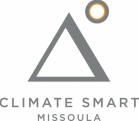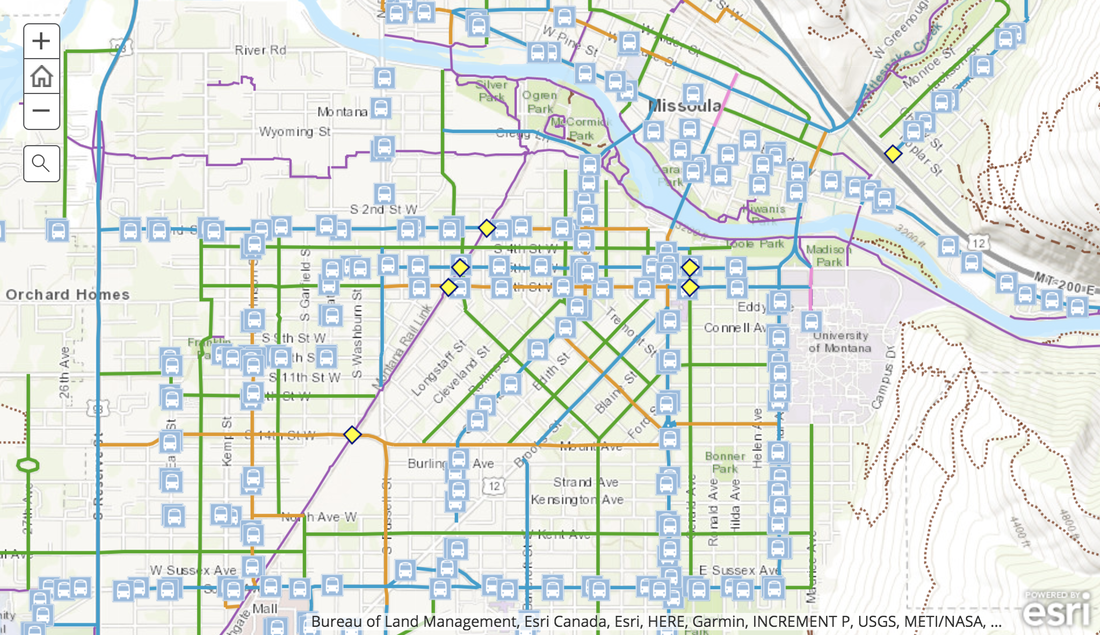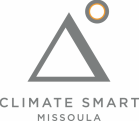|
If the average American were to never turn on their heat, drive their car, or use fossil fuels in any way, each person would still burn through 6 tons of carbon per year. This is because of the systems that are in place around us and the infrastructure that has been built to support the way we live. Smarter land use and growth policies are one way we can create systemic change that allows us to lead lower impact lives. |
Smart Growth is an opportunity to enhance land use planning and support multi-modal transportation goals across Missoula as described in Missoula’s Community Climate Action Plan and Activate Missoula 2045. Our smart growth and transportation efforts are designed to help reduce our community’s greenhouse gas emissions and reflects the value Missoulians place on creating a healthy community where people thrive even in the midst of climate change stress. We can do that by reducing the number of miles we drive in fossil-fueled cars, expanding zero fare bus services and accessibility, making active transportation options safer and more accessible, and fostering transit-oriented development. Missoula is focusing on land use planning that reflects Smart Growth and Complete Streets principles to achieve those goals.
Envisioning a Healthier, Equitable, and Multi-Modal Future
Utilizing Smart Growth and Complete Streets principles means planning and designing our communities with all people in mind.
|
Smart Growth Principles
|
Balancing safety and convenience and developing communities that are beautiful and livable is the foundation of Smart Growth. Complete Streets help us envision Missoula as a place where you enjoy walking, rolling, biking, roller blading, scootering, or busing to get where you need to go. We think those streets should look something like this: |
Complete Streets
The City of Missoula adopted a Complete Streets Resolution in 2016 and is therefore prioritizing development that integrates safe, convenient, and healthy transportation options for people of all abilities. This means shifting away from prioritizing wide roads with multiple traffic lanes and considering streets with:
|
ACT, ADVOCATE, and ASSIST for SMART GROWTH
|
ACT
Take the bus to work, walk to the grocery store, ride your bike to a trailhead. Utilizing active transportation modes and public transit is visual proof of our community values. Logging your commutes (telecommuting and remote work counts!) on Way to Go helps the city to understand our transportation values and justify allocating proper funding to improve or develop the infrastructure we really need. |
ADVOCATE
Land use planning is the biggest tool we have for implementing smart growth and complete streets and your voice is a key in shaping the big picture. Use this page and the information below to keep up to date with transportation infrastructure changes, budget hearings, city council meetings and other opportunities to provide your input. |
ASSIST
There are a number of organizations and agencies in town that are working diligently to improve our sustainable transportation infrastructure. Consider donating to their efforts, offering feedback, or volunteering for upcoming events (once our city resumes public meetings of course) Missoula in Motion Bicycle and Pedestrian Program Free Cycles / Missoula Institute for Sustainable Transportation Climate Smart Missoula |
2020 Infrastructure Updates
Keep up to date with infrastructure changes happening in Missoula that support our active transportation goals or offer the opportunity for you to advocate for Smart Growth.
Mullan Area Master Plan
MULLAN AREA MASTER PLAN
This planning and design process will affect the development of 2,000 acres on the westside of Missoula. The Missoula County Consolidated Planning Board will finish their discussion of the plan on October 20, 2020.
This planning and design process will affect the development of 2,000 acres on the westside of Missoula. The Missoula County Consolidated Planning Board will finish their discussion of the plan on October 20, 2020.
EAST MISSOULA HIGHWAY 200 CORRIDOR PLAN
EAST MISSOULA HIGHWAY 200 CORRIDOR PLAN
The Missoula Metropolitan Planning organizations is seeking public comment on a road improvement project for Highway 200 between Van Buren Street and Tamarack Rd. Visit their site to get learn more, find updates on upcoming open houses, view a map of the project and get involved by making comments accepted until June 2020 when an open house will be held.
The Missoula Metropolitan Planning organizations is seeking public comment on a road improvement project for Highway 200 between Van Buren Street and Tamarack Rd. Visit their site to get learn more, find updates on upcoming open houses, view a map of the project and get involved by making comments accepted until June 2020 when an open house will be held.
Bus Stop Master Plan
BUS STOP MASTER PLAN
Mountain Line has been conducting a systematic review of its 450 bus stops in order to implement its Bus Stop Master Plan and improve safety, increase accessibility, and maximize service efficiency. In 2020 Mountain Line will improve ADA accessibility for all stops on routes 1 and 2.
Mountain Line has been conducting a systematic review of its 450 bus stops in order to implement its Bus Stop Master Plan and improve safety, increase accessibility, and maximize service efficiency. In 2020 Mountain Line will improve ADA accessibility for all stops on routes 1 and 2.
Long Range Transportation Plan update - Missoula connect
LONG RANGE TRANSPORTATION PLAN UPDATE - MISSOULA CONNECT
From 2020-2021 the Missoula Metropolitan Planning Organization is engaging in a long range transportation planning update called Missoula Connect. They are currently soliciting feedback from Missoulians in order to prioritize investments that respond to our needs. Visit Missoula Connect to learn more and take their survey and let them know what's important to you.
From 2020-2021 the Missoula Metropolitan Planning Organization is engaging in a long range transportation planning update called Missoula Connect. They are currently soliciting feedback from Missoulians in order to prioritize investments that respond to our needs. Visit Missoula Connect to learn more and take their survey and let them know what's important to you.
HIGGINS AVE BRIDGE REHABILITATION
HIGGINS AVE BRIDGE REHABILITATION
Construction is scheduled to begin in October 2020. The bridge will be receiving some much needed updates as well as a reduction in driving lanes, widening of the pedestrian pathway and the introduction of shared use paths on either side of the bridge that will protect both pedestrians and cyclists from risk associated with vehicle traffic.
Construction is scheduled to begin in October 2020. The bridge will be receiving some much needed updates as well as a reduction in driving lanes, widening of the pedestrian pathway and the introduction of shared use paths on either side of the bridge that will protect both pedestrians and cyclists from risk associated with vehicle traffic.
.




